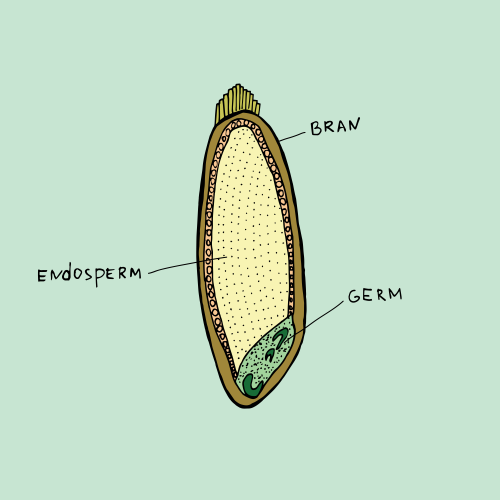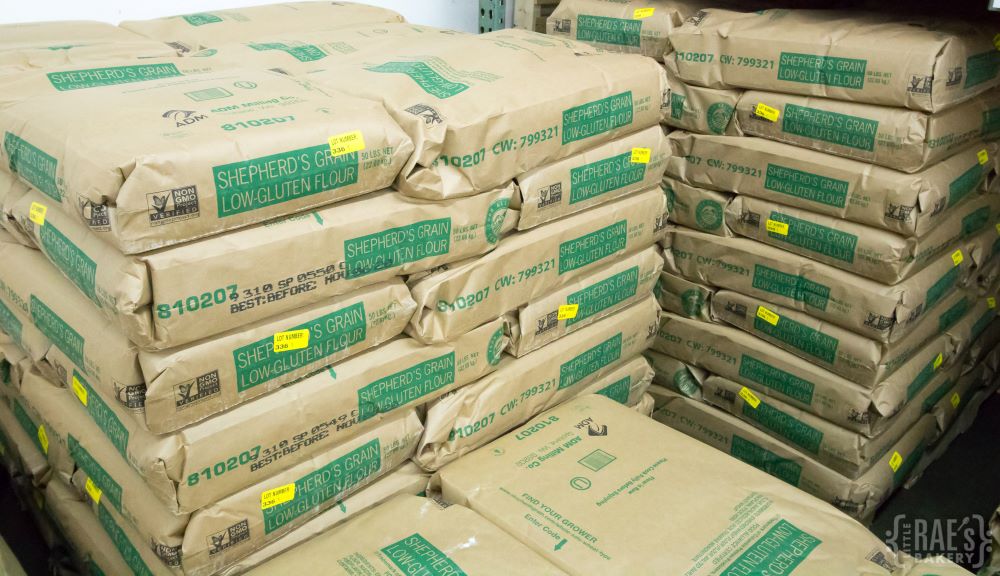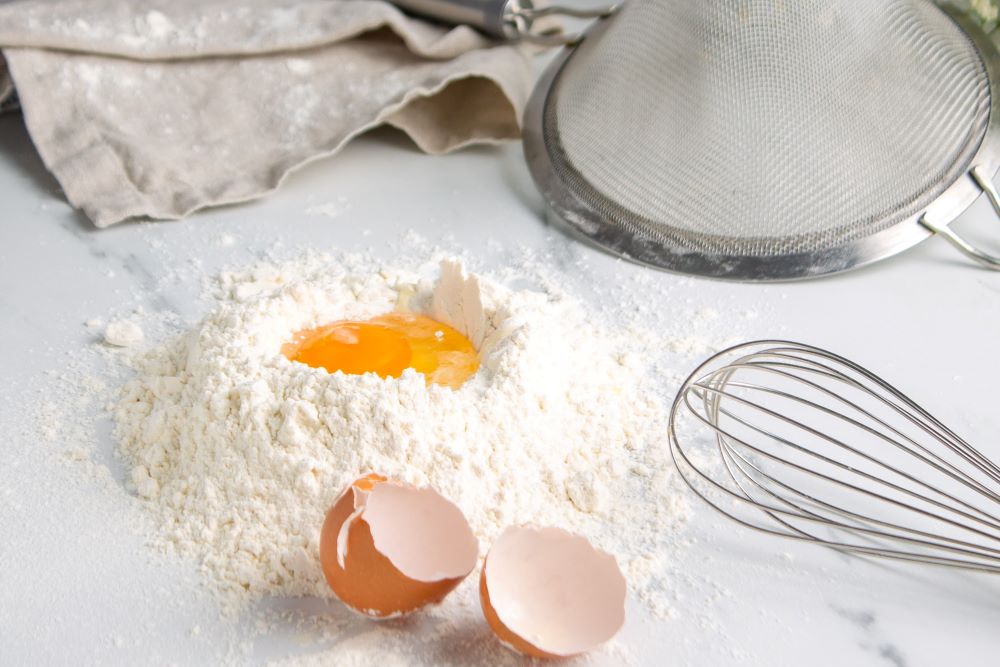Where it all began
As long as we’ve been recording history, men and women have ground grain to make their daily bread. Traditionally, grains like wheat have been stoneground, which simply means that some variety of stone contraption was used to mill the flour. Throughout history, different cultures developed their own, increasingly modern methods for grinding flour.
Ancient Egyptians used a stone mortar. Later, that gave way to a design using two round stones stacked atop one another, where the top stone was turned with a handle. Eventually, user- and animal-powered milling methods were replaced with mills powered by wind and water. These methods were much more powerful and used two large stones to grind wheat slowly and gently.
White flour as a status symbol
Flour milled using the above methods is known as stoneground flour. It retains all the parts of the wheat kernel—the bran, endosperm, and the germ. The bran and germ are the bulkiest components of the wheat grain (also the most nutritious), so stoneground flours that leave these intact are coarser and have less rise when used in baking.

Ancient Egyptians are the earliest recorded example we have of humans seeking a finer texture for flour. Around 3000 B.C.E., the Egyptians began sifting flour using hand sieves. This helped separate the coarser parts of wheat grains from the finer grains—in essence, creating the first version of “white” flour. Achieving this finer flour was a time-consuming process, and typically only royalty could afford it.
Similar practices have been used by many cultures across the centuries. For example, in Medieval England, various cloths of differing weaves were used to sift flour in a process known as “boulting.” With this finer flour, lighter and more exquisite baked goods could be produced—but only for those who could afford it.
Because of the cost associated with achieving a light texture and whiter appearance, flour sifted in this way was a status symbol. Common people could only afford the coarser stoneground wheat flour, and the poorest individuals used cheaper varieties of flour made from grains like rye and barley.
White flour – then vs. now
Until about 1870, “white” flour was created using this sifting method. While the bulky parts of the bran and germ were removed physically, the flour still contained wheat germ oil, which passed on some of the nutrients from the wheat germ.
However, between 1870 and 1890, the modern practice of milling flour using steel rollers became extremely popular. This commercial process not only milled flour at a high speed, but also enabled millers to separate the different parts of the wheat kernel. Thus, flour could be produced much more quickly, and millers could cut out the bran and germ and use only the soft endosperm.
The result? Completely automated production of very fine white flour that the common household could more easily afford. In addition, this flour didn’t include any wheat germ oil, making it far more shelf-stable as well as more attractive (a purer white vs. the grayish-white of hand-sifted white flour or stoneground flour).
Within about 10 years of the introduction of commercial steel roller mills, many stone-grinding mills across Europe and North America went out of business—they couldn’t compete with the efficiency of modern mills or the public desire for white flour. Everyone wanted a little bit of “royalty” in their home.
Delicious, but not so nutritious

While mass production of white flour was extremely popular (as well as lucrative for the milling industry), some unexpected and very big problems came with its rollout.
Previously, common households used traditional stoneground flour varieties, which included all the naturally occurring vitamins and minerals from the bran and germ of the wheat kernel. Steel roller mills, however, discarded the bran and germ, leaving only the endosperm—a soft but nutritionally useless part of the wheat grain. Without these nutritious parts of the grain or even the oils from them, white flour produced with steel roller mills had virtually no nutritional value.
This was problematic especially for the poorest households, for which wheat flour products had previously provided a significant portion of their daily nutrition (a reality that holds true even today). Studies estimate that by the 1930s, the average American was only getting one-third of the amount of thiamin as compared to when stoneground flour was the only variety available.
As the preference for and consumption of white flour grew, deficiency-related illnesses started popping up—like beriberi (thiamin deficiency), pellagra (niacin/tryptophan deficiency), and anemia (iron deficiency).
In the 1920s, Benjamin R. Jacobs began to document how modern milling practices resulted in the loss of vital nutrients. Recognizing that the milling industry was not simply going to revert to stoneground practices, he also began advocating for the addition of some of the lost nutrients—a practice we know today as enrichment. (Side note: while enrichment adds back nutrients that were naturally occurring in a product, fortification adds nutrients that weren’t there before)
The first tests of flour enrichment began in the 1930s. In 1941, the U.S. began mandating the enrichment of white flour-based food with iron, niacin, thiamin, and riboflavin (folic acid was added to this list in the 1990s). While this practice did not make white flour as nutritious as stoneground flours, it did almost immediately eradicate the deficiency-based illnesses that had been observed.
Modern-day white flour

Now that the nutritional implications are well known, these days it is illegal in most countries to sell white flour that has not been enriched. While enrichment is not a perfect solution, it does help to prevent large-scale vitamin and nutrient deficiencies like what we saw just a century ago.
White flours like all-purpose flour in the U.S. remain the go-to flour for most home bakers and many commercial operations because it produces lighter products, better rise, and the finer texture of baked goods that we’ve become accustomed to.
However, because of the highly processed, stripped-down nature of white flour, some prefer only whole grain flours. They see these flours as simpler, less processed, and with their full nutritional values still naturally intact.
Here at Little Rae’s, we use a variety of flours for our wide variety of products. All our flour comes from Shepherd’s Grain, whose independent growers use sustainable farming methods to produce high-quality flours.
Fred Fleming and Karl Kupers, the co-founders of Shepherd’s Grain, are beyond passionate about supporting family farms and pioneering new methods in sustainable farming. We couldn’t be prouder to support them in their mission to forge a more positive legacy for people and for our planet. Shepherd’s Grain is truly leading the way in an era when we are collectively looking back to learn lessons from the past to create a more sustainable and healthier future for all.
Want to learn more about the most common types of flours? Be sure to check out our blog, This or That? How Ingredient Swaps Impact Your Recipes, Part 2 (hint: It’s the one about flour!).

